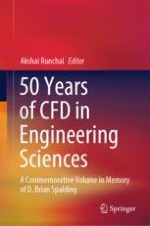2020 | OriginalPaper | Chapter
The SUPER Numerical Scheme for the Discretization of the Convection Terms in Computational Fluid Dynamics Computations
Authors : N. C. Markatos, D. P. Karadimou
Published in: 50 Years of CFD in Engineering Sciences
Publisher: Springer Singapore
Activate our intelligent search to find suitable subject content or patents.
Select sections of text to find matching patents with Artificial Intelligence. powered by
Select sections of text to find additional relevant content using AI-assisted search. powered by
